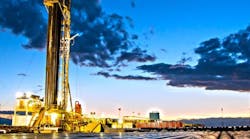Tayvis Dunnahoe
Exploration Editor
As the 85th Annual Meeting of the Society of Exploration Geophysicists gets under way this week in New Orleans, it is likely several keynote speakers at the event will address spending cuts related to the oil price's downward spiral over the last year.
Throughout 2015, analysts have noted that exploration companies have tightened their spending with new and developing fields. In this year's first quarter, oil prices dropped to an average $44/bbl at the end of January after averaging $105/bbl for the previous 3 years-a 55% decrease.
According to Elsevier R&D's "2015 Exploration Trends in a Low Price Oil & Gas World," the industry spent $800 billion in 2014. Exploration and development projects are feeling the brunt of lower oil prices as spending budgets decrease. Baker Hughes Inc. reported that the US drilling rig count had dipped to its lowest level since May 3, 2002 (OGJ Online, Oct. 9, 2015). Nearly 1,200 rigs have gone offline year-over-year.
With the oil price settling at $47/bbl on Oct. 12, budget constraints are altering the landscape for E&D. As early as March, analyst group Wood Mackenzie Ltd. predicted an average reduction of 30% in exploration spending through to 2016. The analyst pointed out that the industry "is addressing a longstanding cost inflation issue." Managing costs and improving efficiency will be necessary.
Comeback
There is no certainty as to when oil prices will reverse course; however, as the price begins to recover, exploration companies will take advantage of lower costs.
According to WoodMac's report-"Upstream cost deflation: How much could costs of exploration fall?"-companies that hold spending flat or make only modest cuts could yet achieve "more with less." Operators that work countercyclical by increasing drilling in high-impact plays may come out ahead within the next year if prices should recover sooner than expected.
Before the oil price's fall below the $100/bbl threshold, drilling and seismic contractors benefitted from some of the strongest margins in the service sector. Cost deflation should exceed development costs, and lower E&D costs can reduce breakeven prices to improve full-cycle economics.
Despite the pressures of lower prices on the E&D business, not all companies are relying on cutbacks as a solution. Some are pulling out altogether and others are forging ahead.
Stepping aside, ahead
Royal Dutch Shell PLC made headlines in October when it announced its exit from the Arctic. Even though the operator encountered oil and gas shows in its Burger J exploration well in Alaska's Chukchi Sea, the results were "not sufficient to warrant further exploration," the company said (OGJ Online, Oct. 5, 2015).
Shell has halted further exploration activity offshore Alaska for the foreseeable future. This decision was associated with the project's high cost and the unpredictable regulatory environment, the company said.
Meanwhile, in Malaysia, Petronas has shown a clear drive to move forward despite low prices. According to an interview with Bernama, the Malaysian government news agency, Mohd Redhani Abdul Rahman, general manager, cited aggressive exploration as one of the best practices in Malaysia for the past decade. With more than 970 exploration wells drilled in Southeast Asia, about one fifth of those are in Malaysian waters. Malaysia now contributes 5 billion boe to the region, or half of Southeast Asian output.
The country is planning to create an open data repository starting in 2016 to create opportunities for multiclient deepwater surveys.
The longer view
In 1999, Oil & Gas Journal reported, "Low oil prices in particular are primarily responsible for an expected decrease in seismic spending this year." Total seismic spending was expected to fall to $3.9 billion in 1999 from $5 billion in 1998 (OGJ Online, Mar. 8, 1999). According to Barclays Research, however, seismic spending exceeded $14 billion in 2014 and was expected to reach $15 billion through 2015.
Exploration geophysicists could take comfort in the value of where the next discovery lies. Despite weak oil prices in the near term, the subsurface remains promising with its development opportunities intact.
